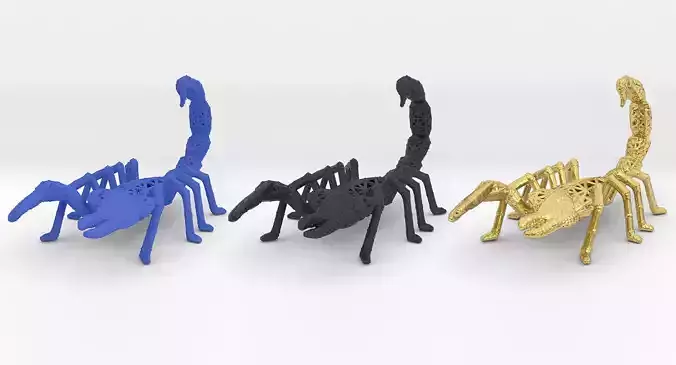1/64
Scorpions are predatory arachnids of the order Scorpiones. They have eight legs and are easily recognized by the pair of grasping pedipalps and the narrow, segmented tail, often carried in a characteristic forward curve over the back, ending with a venomous stinger. Scorpions range in size from 9 mm / 0.3 in. (Typhlochactas mitchelli) to 23 cm / 9 in. (Heterometrus swammerdami).
The evolutionary history of scorpions goes back to the Silurian era 430 million years ago. They have adapted to a wide range of environmental conditions and can now be found on all continents except Antarctica. Scorpions number about 1750 described species,with 13 extant (living) families recognised to date. The taxonomy has undergone changes and is likely to change further, as genetic studies are bringing forth new information.
All scorpions have a venomous sting, but the vast majority of the species do not represent a serious threat to humans and in most cases healthy adults do not need any medical treatment after being stung.Only about 25 species are known to have venom capable of killing a human.In some parts of the world with highly venomous species human fatalities regularly occur, primarily in areas with limited access to medical treatment.Scorpions are found on all major land masses except Antarctica and New Zealand. Scorpions did not occur naturally in Great Britain, Ireland, Japan, South Korea, and some of the islands in Oceania, but now have been accidentally introduced in some of these places by human trade and commerce.[5]:249 The greatest diversity of scorpions in the Northern Hemisphere is to be found in regions between the latitudes 23 and 38°N. Above these latitudes, the diversity decreases with the northernmost natural occurrence of scorpions being the northern scorpion Paruroctonus boreus at Medicine Hat, Alberta, Canada 50°N.[5]:251 Five colonies of scorpions (Euscorpius flavicaudis) have established themselves in Sheerness on the Isle of Sheppey in the United Kingdom.[9] This small population has been resident since the 1860s, having probably arrived with imported fruit from Africa. This scorpion species is small and completely harmless to humans. At just over 51°N, this marks the northernmost limit where scorpions live in the wild.
Today, scorpions are found in virtually every terrestrial habitat including: high-elevation mountains, caves, and intertidal zones, with the exception of boreal ecosystems such as: the tundra, high-altitude taiga, and the permanently snow-clad tops of some mountains.As regards microhabitats, scorpions may be ground-dwelling, tree-living, rock-loving or sand-loving. Some species, such as Vaejovis janssi, are versatile and are found in every type of habitat in Baja California, while others occupy specialized niches such as Euscorpius carpathicus, which is endemic to the littoral zone of rivers in Romania._Notes:3d print ready , 3ds, wrl , obj, max, stl , fbx, dwg and dfx formats are included, the 3ds format is low poly , rest is high poly, hope you like the model and dont forget to leave a review._
REVIEWS & COMMENTS
accuracy, and usability.
































































